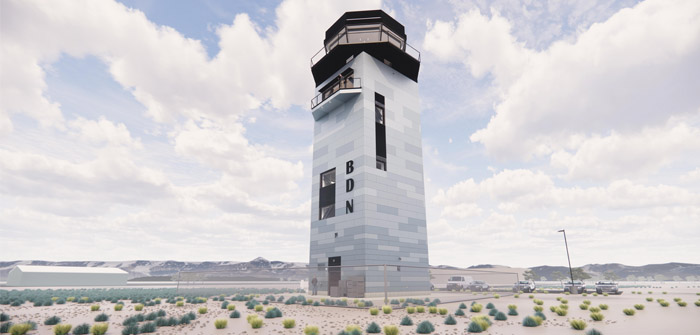(The 115-foot air traffic control tower is designed to bring greater safety to Central Oregon skies | Rendering courtesy of Morrison-Maierle)
The seven-story Oxford Hotel, at 70 feet in height, will lose its claim to being Bend’s tallest building once the Bend Municipal Airport’s new air traffic control tower is completed in the fall of 2025. Standing at 115 feet, the “first-class, state-of-the-art facility,” in the words of Airport Manager Tracy Williams, will be strategically located on the 420 acres that serve as home to some 300 aircraft, and is being designed to “bring greater safety to Central Oregon skies.”
Bend’s airport — with around 140,000 takeoffs and landings per year, or 380 per day—is the third busiest in the state, and the only one of Oregon’s top-five busiest airports without a tower to direct traffic. (Of Oregon’s 97 public airports, eight have air traffic control towers, according to Williams. Bend will be the state’s ninth tower.)
Currently, she explained, pilots must communicate with each other directly to coordinate who’s next to take off and land. With the new tower, air traffic controllers will orchestrate safe separation of aircraft and proper sequencing from a perch about 85 feet above the single, 5,200-foot runway that gives them a 360-degree view around the airport. “It’s all about safety, safety, safety,” Williams said. “The pilots are just overjoyed.”
She noted that control towers “don’t get built that often, perhaps two new a year, not counting sponsor-owned and funded control towers such as the one dedicated to the late Senator John McCain at Arizona’s Phoenix-Mesa Gateway Airport.”
The reason, Williams said, is that federal support is normally needed to champion such a project. Bend’s $15 million price tag is based on “very good estimates of the total cost, excluding, unforeseen circumstances such as supply chain issues that could come up,” added Julie Thiessen, project manager and senior airport engineer at Morrison-Maierle.
The final piece of the $15 million funding puzzle fell into place this month when Oregon Senators Jeff Merkley and Ron Wyden announced that the Federal Aviation Administration (FAA) is awarding $17,364,442 to the state under the Airport Improvement Program, including $3.75 million to Bend Municipal Airport for its new control tower.
(Roberts Field in Redmond received $1.3 million, which Airport Manager Zachary Bass said “was expected and is part of our annual entitlement from the FAA.”)
In addition to Senators Merkley and Wyden, Williams singled out Lori Chavez-DeRemer — previously a member of the U.S. House of Representatives who was just chosen to serve as labor secretary by the incoming president—for her support. She also credited the FAA for giving the project “higher priority than other similar projects in the past, as they don’t fit within the agency’s normal funding scheme.”
“Coincidentally, the combination of various federal and state grants that will fund the project came in within months of each other,” said Williams, who admitted to periodically losing sleep up until that point. (She began the grant application process back in 2020, when assuming her airport manager position.)
“Tracy did her job remarkably well,” praised Thiessen, “meeting with the legislators face-to-face in Washington, D.C., and explaining in detail where the requested money would be going” and the benefits that would be entailed — not just for Bend, but for Central Oregon overall — in helping reduce congestion in the air. “Her efforts were key to the project’s funding success,” Thiessen said.
Williams emphasized that there are no plans to bring commercial flights to Bend. “There’s no reason to compete with Redmond, especially since Bend is heavily used for general aviation and business and its runway isn’t long enough to accommodate commercial jets. This is how we distinguish between the two airports.”
Nor is the control tower project designed to attract other larger aircraft. “All of our planes meet the criteria of having a 79-feet-wide wing span, and a 30,000-pound, single-wheel, weight-bearing capacity,” Williams said. “While the new tower might change the mix of aircraft, there is still a limit on who can come in.”
Both Williams and Thiessen noted that collaboration has been integral to the project from its earliest pre-funding days — a prime example being the initial site selection study that involved some 45 professionals (including an air traffic control manager from the Redmond Airport) who spent a day together discussing details as minute as adjusting window mullions in the control tower to prevent aircraft signals from being obscured, and rotating the tower ten degrees off center. “Everyone got to weigh in,” Williams said.
“Working under the FAA’s strict schedule (as the agency will staff the tower and develop a timeline for hiring and training), everyone is stretched thin, and we have less overall time to solve concerns that might come up,” added Thiessen. “Our constant collaboration, transparency, and open communication foster more efficient problem-solving, and have been key to the success of the project thus far.”
“It’s a great example of collaboration,” Williams agreed, “and in fact, will be used as a model for the FAA when moving forward. Although not realizing it at the time, we were trailblazers.”
The two professional partners summed up the positive momentum that has been forged among project participants and stakeholders: “We’re still in pattern and on the approach,” they said.


